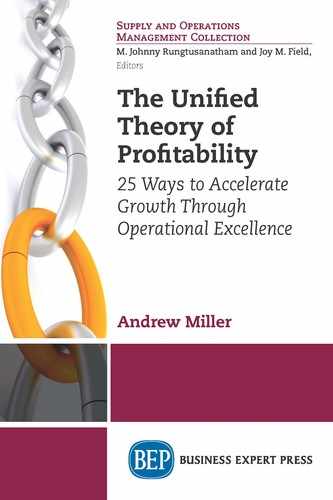Unfortunately, none of us has a crystal ball that we can look into and see the future. If we did, we would not make mistakes. The most successful companies, however, do their best to use discipline, common sense, and critical thinking to best exploit opportunities. By becoming better at identifying and exploiting opportunities, you will become a more successful organization.
This chapter focuses on how to better assess and exploit new opportunities. Too many organizations pursue every opportunity that comes their way and it hurts their ability to grow quickly and successfully. This chapter gives you strategies on how to identify those opportunities that can have the biggest impact. Usually, becoming better at assessing and pursuing new opportunities means you actually pursue fewer opportunities.
I had this conversation early on with a new client a few months ago. He brought me in to help his organization win more business through competitive procurement processes. The first thing I told him was, “The way you are going to win more business is by participating in fewer opportunities.” I thought he was going to throw me out of his office. Sales organizations like to pursue every opportunity. I went on to explain that one has a better chance of closing business when you pursue those opportunities that align with your strengths, competitive advantages, relationships, ideal customers, and strategic direction.
The following assessment is one that I have used successfully with clients across North America and it has helped every single one of those clients accelerate growth and dramatically increase revenues. It provides them the discipline to assess every opportunity with the same decision-making criteria, with a focus on growth potential, relationship, and alignment with corporate direction.
Think of an opportunity you are considering pursuing and score yourself on each of the 10 statements in Figure 28.1.

Figure 28.1 Opportunity assessment matrix
Give each statement a score from 1 to 4 based on the scoring legend.
Additional questions to consider:
• What additional insights do we have about the customer organization?
• Was price a significant component of the evaluation criteria? If yes, can we compete on price?
Now do the same thing with an opportunity that you recently pursued and was successful. What was your score?
Now do it again with an opportunity that you recently pursued and was not successful. What was your score?
Do you see any Pattern?
Usually, when I implement this assessment with clients, we customize the statements to better fit their business. We then go back 12 to 18 months and retroactively assess past opportunities against this customized assessment. We always see a trend. The opportunities that scored higher tended to be the most successful, and the ones that scored lower were not successful. In some cases, we were even able to develop a threshold where the client knew to stop pursuing any opportunity below a certain score.
This is how you improve your ability to assess and exploit opportunities—by pursuing the best opportunities.
Use this assessment. Develop one of your own. Change the statements to fit your own business. The key is instilling discipline in decision making so that you pursue the best opportunities and can maximize their impact.
Do you pursue only the best opportunities or every opportunity that comes your way?
